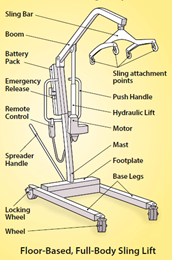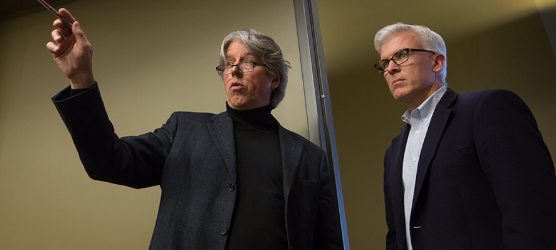INJURIES FROM MECHANICAL LIFTS IN NURSING HOMES
Call Us Today
(763) 746-7800
Get a Free Consultation
Contact Us Today
Many elderly patients who reside in nursing homes are unable to move and transition from one area to another without assistance. Indeed, for some patients, it is not just walking long distances that is impossible, but even moving from a chair to the bed, bed to the bathroom, etc. As such, Hoyer Lifts are often used. Unfortunately, negligence while operating these lifts often leads to patient injuries.
WHAT IS A MECHANICAL LIFT?
 Many residents in nursing homes are unable to transfer themselves into and out of bed or wheelchair. Attempting to lift and move a human being without using proper equipment can be dangerous to the resident and the staff.
Many residents in nursing homes are unable to transfer themselves into and out of bed or wheelchair. Attempting to lift and move a human being without using proper equipment can be dangerous to the resident and the staff.
Mechanical lifts, when used properly, can be an effective and safe way to transfer disabled residents. Use of proper equipment, by properly trained staff, who follow the proper procedures are essential factors for transferring a dependent resident safely. Nursing homes and staff who cut corners in any of these factors can cause devastating injury.
MECHANICAL LIFT POLICIES IN NURSING HOMES
Because residents are lifted off the ground when using a mechanical lift, it is incredibly important that the lifts are used properly to reduce the risk of the patient falling out or sustaining other injury types. An injury to a patient may occur if the resident is not properly strapped into the lift, or is not placed in the correct position in the lift. If a patient falls out of a mechanical lift, they could sustain serious injuries, including bone fracture injuries, internal injuries, spine injuries, or/and a traumatic brain injury. Elderly people are very frail, and a fall that would not cause long-term harm to a younger, healthier individual could be fatal for a nursing home resident.
Do most nursing homes have policies surrounding the use of mechanical lifts to ensure the safety of the residents?
- Nursing homes have a legal duty to protect their residents’ safety and to use assistive equipment safely (such as wheelchairs and mechanical lifts).
- The nursing home must have sufficient numbers of competent staff who are properly trained to meet the needs of each resident. The nursing home must ensure that when it assigns personnel to care for a resident, the personnel are able to perform each care function safely.
- The nursing home must have policies and related staff training regarding the responsibilities to properly care for the facility’s residents. The training must provide the direct care staff with the knowledge to safely use assistive equipment for a resident, including the specific details set forth in the equipment’s operator’s manual.
FREE CONSULTATION
HOW DO MECHANICAL LIFT INJURIES OCCUR?
When a mechanical lift injury occurs that would not have happened but for a nursing home professional’s failure to exercise the proper level of care, the nursing home can be held liable for any harm that results. This might include funeral and burial expenses, medical expenses, pain and suffering, and other economic and noneconomic losses.
How do injuries occur when using a mechanical lift to transfer a nursing home resident? Are there some common circumstances in these injuries?
- The lift or sling malfunctions due to improper inspection, maintenance, or repair. Nursing home staff must examine the sling and its loops (or other attachment areas) for tears, holes and frayed seams. They must not use a sling that has any indication of wear.
- The staff does not comply with the operator’s manual. Most lifts require two or more caregivers to operate lift and handle patient safely. Did the nursing home have enough staff on duty to perform the two-person operation?
- The staff uses the wrong type of sling for the patient (too small or too big) or the lift (wrong manufacturer or configuration). The nursing home personnel must use only a sling that is specifically designed for the particular lift. Staff must also check the weight limits of the lift and sling, and ensure that the resident’s weight does not exceed the limits. Using the wrong sling can cause serious injury.
- The staff fails to secure the loops of the sling to the lift. Failing to properly secure the loops of the sling on the hooks of the lift can cause the resident to become unstable and unsupported, resulting in the resident falling out of the sling.
- The staff fails to place the resident securely in the sling. Failing to properly position the resident in the sling can cause the resident to become unstable and unsupported, resulting in the resident falling out of the sling.
- The nursing home personnel lift the resident without performing a proper safety check. They must inspect all hooks and loops (or other fasteners) to make sure they do not detach during use. They must also make sure that the straps are properly positioned before lifting the resident. They must make sure that the hooks, fasteners, and straps remain securely fastened throughout the lifting process.
- The staff moves the equipment improperly and causes the resident and lift to become unstable.
- The staff fails to make sure that the floor and space around the lift are clear so that the lift can turn and move unhindered.
WHAT TYPES OF INJURIES CAN OCCUR FROM A MECHANICAL LIFT IF NOT USED PROPERLY?
What type of injuries may occur when nursing home personnel use a mechanical lift to transfer a resident?
- Misusing a mechanical lift while transferring a resident can cause serious bodily injury, including head trauma, spinal cord injury, fractures, and death. When the nursing home personnel cause the resident to fall out of lift, the resident’s body may strike the metal lift equipment, another piece of equipment (such as a wheelchair), or the hard surface of the floor. It is not uncommon for the resident’s head, which is relatively heavy and unsupported, to have a significant impact against the hard floor after falling several feet from the suspended lift.
WHAT TO DO AFTER A MECHANICAL LIFT INJURY?
Are there procedures that nursing home facilities need to follow after a lift injury?
- The resident should not be moved until a proper assessment by a physician or registered nurse is performed to evaluate the extent of injury.
- Nursing homes have a duty to investigate the staff’s failure to provide the goods and services that were necessary to avoid physical harm, pain, mental anguish, or emotional distress to a resident.
- Duty to ensure equipment is working properly and to remove unsafe equipment from service.
- Duty to report adverse events to the department of health or police.
- Legal duty to preserve evidence (equipment, records associated with the resident’s condition and treatment).
What advice would you give to family members of nursing home residents that have been injured due to improper lift use? What actions if should they take?
- Consult with an attorney who is experienced in handling injuries involving mechanical lifts to transfer nursing home residents.
- Is the resident able to talk about what happened, if so, what happened?
- Who was involved?
- When and where did it happen?
- How did it happen?
- Who witnessed it? If so, what did they see and hear?
- What equipment was involved?
- What has the nursing home done to inspect the equipment?
- What has the nursing home done to preserve the equipment?
- Photographs of the resident’s injuries (sadly, they frequently look like they’ve been involved in a catastrophic car crash or boxing match).
- Photographs of the environment where the lift injury occurred and of the equipment involved.
- The resident’s records at the nursing home, of paramedics and other emergency responders, the emergency room and hospitalization records, and (if applicable) the medical examiner’s files.
OUR MINNESOTA NURSING HOME NEGLIGENCE ATTORNEYS WILL FIGHT FOR YOUR LOVED ONE
If your loved one has suffered harm as a result of a patient lift accident within a Minnesota nursing home, our nursing home abuse and negligence attorneys will fight on your family’s behalf. Our services include a thorough investigation into the cause of the accident, building your case to prove negligence, and negotiating for damages. If necessary, our lawyers are also experienced trial attorneys who will be prepared to file a lawsuit and take your case to court.
To schedule a free consultation with our Minnesota nursing home abuse lawyers and learn more about what steps to take after a Hoyer Lift accident, call us today or contact us online. We will get back to you as soon as possible.
CASES WE HANDLE
- Bed Rails / Asphyxiation
- Billing Fraud
- Brain Injury
- Burns
- Choking
- Elder Issues
- Falls & Trauma
- False Records
- Fracture Injuries
- Mechanical Lift Misuse
- Malnutrition / Dehydration
- Mechanical Misuse
- Medication Errors
- Nursing Home Overview
- Physical Abuse
- Pressure Sores / Bed Sores
- Decubitus
- Sepsis / Infection
- Sexual Abuse
- Special Focus Facility
- Wandering & Elopement
- Weight Loss
- Wrongful Death
THE ATTORNEYS AT KOSIERADZKI • SMITH
The Kosieradzki • Smith Law Firm represents clients throughout the Minneapolis-St. Paul Twin Cities area, the state of Minnesota and nationally, in cases involving catastrophic injury, including nursing home abuse, wrongful death, medical malpractice, products liability, vehicle accidents, trucking accidents, slip and fall accidents and premises liability, and other serious injuries caused by others’ wrongful and negligent acts.

AWARDS & ACCOLADES












